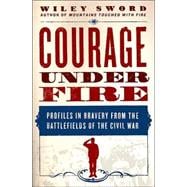
| Acknowledgments | p. xi |
| Preface: Why the Civil War or Its Courage? | p. xiii |
| The Face of Courage | |
| To Obey Orders or Not | p. 3 |
| The Reason Why | p. 8 |
| "To Win Glory Enough" | p. 16 |
| The Face of Courage | p. 28 |
| Two Wars in Concept | p. 37 |
| Ordeal at Atlanta | p. 44 |
| Pat Cleburne, a Man Who Understood | p. 52 |
| What Do You Say When You Know You're About to Die? | p. 64 |
| Physical Bravery | |
| Extraordinary Bravery, a Special Virtue | p. 83 |
| "The Sun Shines Brightly; I See It for the Last Time" | p. 102 |
| "Rally 'Roun de Flag, Boys": The 13th U.S. Colored Troops at Nashville | p. 115 |
| A Woman's Ordeal: Coping on the Home Front | p. 123 |
| Of Agony Extended and Endured | p. 133 |
| Of Valor Less Than Glory | p. 140 |
| The Workings of the Mind | p. 146 |
| Our Consciousness Prevails | p. 163 |
| Doing What Is Right | p. 170 |
| Cowardice, Courage's Cousin | p. 182 |
| What Kind of Courage? | p. 193 |
| Moral Courage | |
| Decisions of Courage | p. 203 |
| Shiloh: The Roll of the Dice | p. 210 |
| Robert E. Lee, a Man for All Ages | p. 224 |
| What Is Justified Caution? | p. 233 |
| A Tale of Two Presidents | p. 240 |
| The Unthinkable | p. 249 |
| Coping Amid the Shadows | p. 261 |
| Matters of Enlightenment | p. 269 |
| The Role of Courage Today | p. 272 |
| Notes | p. 277 |
| Bibliography | p. 295 |
| Index of Military Units | p. 303 |
| General Index | p. 306 |
| Table of Contents provided by Ingram. All Rights Reserved. |
The New copy of this book will include any supplemental materials advertised. Please check the title of the book to determine if it should include any access cards, study guides, lab manuals, CDs, etc.
The Used, Rental and eBook copies of this book are not guaranteed to include any supplemental materials. Typically, only the book itself is included. This is true even if the title states it includes any access cards, study guides, lab manuals, CDs, etc.
Excerpted from Courage under Fire: Profiles in Bravery from the Battlefields of the Civil War by Wiley Sword
All rights reserved by the original copyright owners. Excerpts are provided for display purposes only and may not be reproduced, reprinted or distributed without the written permission of the publisher.